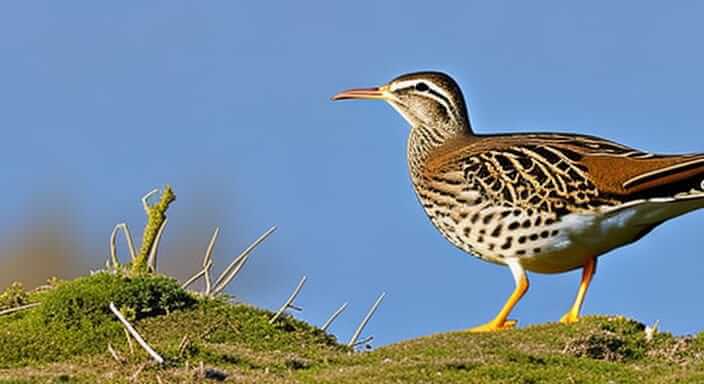What is woodcock? Information about the woodcock bird habits, features and reproduction. What does a woodcock bird look like?

Woodcock Bird; a well-known American game bird (Philohela minor), belonging to the sandpiper family (Scolopacidae). The body is full and robust, the wings short and rounded, the head and eyes very large, and the bill straight, tapering from the stout base, grooved for nearly the entire length, and exceedingly sensitive at the end. The legs are very short for a snipe. The woodcock is 10 or 12 inches long and weighs from 7 to 9 ounces, the female being the larger bird. The colors are a soft harmonious blend of various shades of brown and gray, with black mottling above, nearly uniform pale brown below.
Habits:
The woodcock seldom ventures beyond the limits of the eastern half of the United States at any season, except to invade Ontario and other southern provinces of Canada. In winter it migrates to the South Atlantic and Gulf states, but mostly it breeds in the Central and Northern states. Migration northward begins very early, and many of the more hardy individuals reach the Middle Atlantic and New England states in early March before the frost has left the ground. At such times, and also in the late fall, they secure their food, consisting of insects and their larvae and snails, by turning over fallen leaves; but during summer and whenever the ground is sufficiently soft, they probe it with their long sensitive bills and extract with great skill the earthworms which constitute their chief food. Even when the bill is plunged deeply into the earth, the large eyes, placed very high on the head, permit unobstructed vision in all directions.
Woodcocks frequent bogs and swampy places along alder-grown streams and hillside springs during summer; but in autumn they forsake these coverts for cornfields and undergrowth of low woods, the surest indication of their presence being their perforations in the soft earth. As the large size of the eye suggests, the woodcock is crepuscular and nocturnal. The period of its greatest activity is in the hours immediately succeeding sunset and preceding dawn, although, when the moon is full, it may be abroad throughout the night. During the day it remains hidden in deep bogs and thickets, rising only when frightened; then, springing perpendicularly above the bushes, it flies in an irregular course for a short distance and drops as suddenly to the ground.
In April or even earlier it builds a simple nest of leaves and grass in a dry, well-concealed spot in a bog and lays four buffy eggs spotted with dark brown and lilac. After incubation the fluffy brownish white chicks leave the nest at once, led away by the parent. The parent is very solicitous in the care of its young and not only feigns injury to entice an intruder from their vicinity but has been said to carry them, one by one, between its thighs to a place of safety.
Courtship:
The courtship flight of the male is curious and interesting. After a series of nasal peents, delivered with much apparent effort, he springs from the ground and mounts high in the air on whistling wings in a long circular flight. He then zigzags slowly earthward, each phase of the descent being accompanied by a series of clear and musical notes. This music is partly vocal in origin but in part is produced by the vibration of the air through the outer wing quills, which are stiff and narrow. The male bird then drops like a plummet to the exact spot from which he took wing. He is quite fearless when engaged in his courtship flights, which are repeated at short intervals and may be observed, even with the aid of a flashlight, without disturbing him. With the coming of hard frosts, most of the woodcocks leave for the South, and become concentrated in favorite bottoms along the lower Mississippi River area and other sections of the Gulf states.
As Game:
Next to the quail the woodcock is perhaps the most popular game bird of the eastern United States, and deservedly so. Its numbers, however, have greatly decreased. Only if there is strict regulation of the hunting season and if suitable brushy cleared areas are provided in the woods can the woodcock be preserved as an important game bird. Because of its peculiar appearance and big head, sportsmen have several amusing vernacular names for this bird, such as “timberdoodle.”
The European woodcock (Scolopax rusticóla) is similar to the American species, but is larger and is prominently barred below. Three additional, but little-known, species of woodcocks are resident in the East Indies. The most remarkable of them is known only from the little island of Obi in the Moluccas.